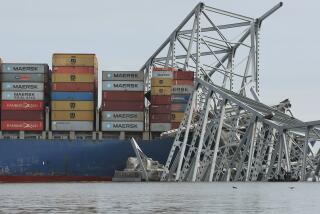Bay Bridge Repairs Put Percol in Business
- Share via
The reopening of the San Francisco-Oakland Bay Bridge on Saturday was something of a grand opening for Fountain Valley-based Percol Polymerics Inc.
The chemical company is only a few weeks old--its Orange County office doesn’t even have all of its furniture and there are only four full-time employees. Yet Percol has spent its first weeks using its patented polymer to fill potholes and tiny trenches left in the Bay Bridge by the Oct. 17 earthquake, which caused a 50-foot section of the span’s upper roadway to drop onto the lower section.
“We can launch our product in a grand style,” founder Ransome Wyman said. “It’s an unusual opportunity.”
Just days after the 7.1 quake, Wyman was called in because his polymer--Transfixx--is faster than traditional road-patching materials.
Transfixx is a combination of two liquids--not much thicker than water--that is mixed into the hole with a solid material such as concrete. Once inside the hole, the liquid expands to fill any empty space and helps adhere different sections of pavement.
So far, Percol has applied about 2,000 gallons of Transfixx to the bridge.
The substance is considered superior to other existing formulas because it’s stronger and takes only two to three minutes to dry as opposed to the normal two hours.
“We can put traffic on it in about 10 minutes,” said Robert Coe, a Caltrans maintenance superintendent.
Percol has done experimental work for Caltrans--Transfixx was used on a five-mile stretch of the Santa Ana Freeway in Orange County--but the Bay Bridge job is its first piece of contract work.
Wyman and a partner developed Transfixx in 1983 for the quick repair of Air Force runways.
“The goal was to be able to restore a bombed runway within four hours of attack and that is in any weather, hot or cold, wet or dry,” said Wyman.
The Air Force tested the product at a NATO base in West Germany.
Transfixx worked just fine but the repairs took a lot longer than four hours.
“It took four days,” Wyman said. “The crews were not properly trained.”
More to Read
Inside the business of entertainment
The Wide Shot brings you news, analysis and insights on everything from streaming wars to production — and what it all means for the future.
You may occasionally receive promotional content from the Los Angeles Times.










